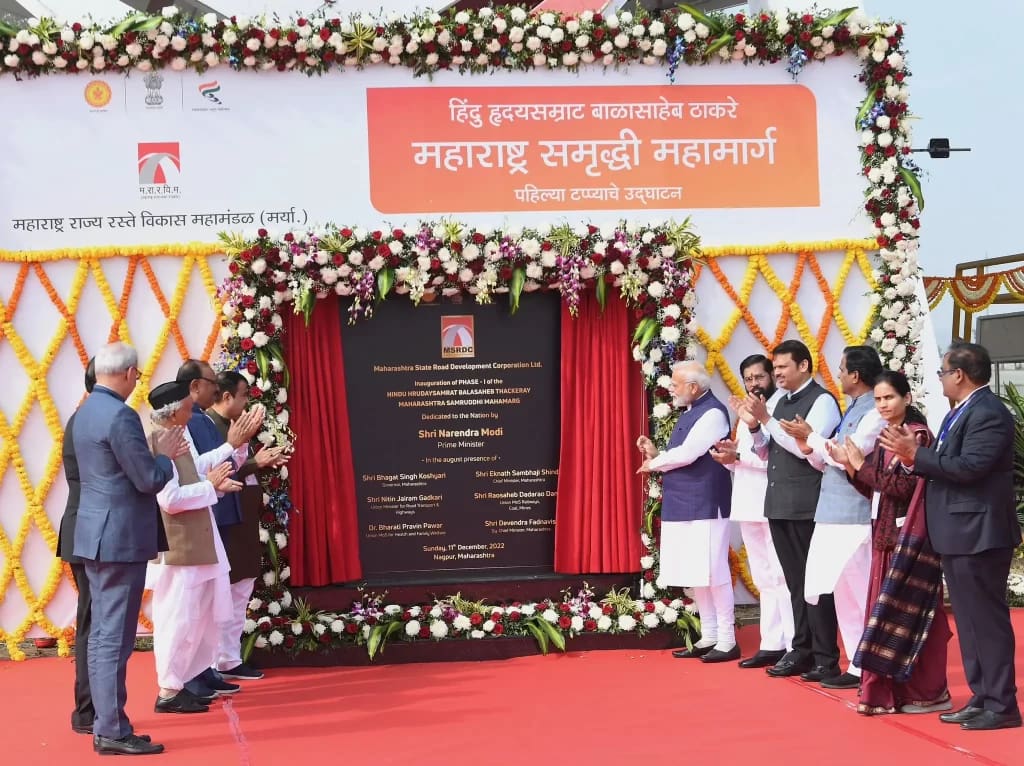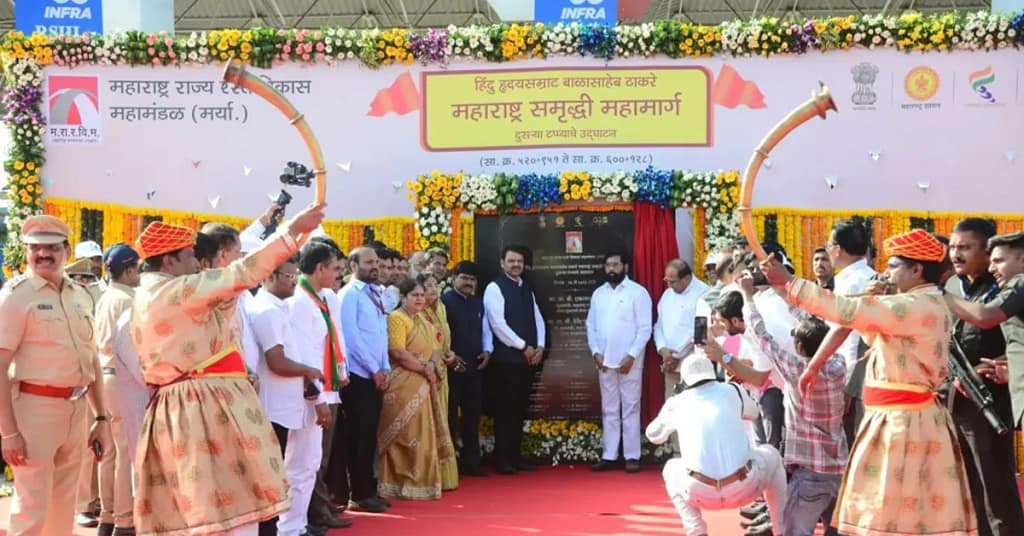It is said that roads are carriers of prosperity. The Maharashtra Samruddhi Mahamarg (MSM), slated to be the main artery in Maharashtra’s transport network, will not only join the two cities of Mumbai and Nagpur, it will also prosper the 390 + small and large villages and towns between these two cities. The rural economy, per se, will get a fillip in many ways. Farmers will be able to supply their produce directly to various markets across the state and country at a cheaper price and lesser time. Also, improved connectivity will help set up numerous rural industries to create job prospects for the local youths. With JNPT on one side and MIHAN on the other, the Samruddhi Expressway will encourage more exports from the rural areas by providing faster access to sea and air transport.
It’s amazing to know that the concept of this pathbreaking mega infrastructure was cultivated by Devendra Fadnavis for 20 years through his journey from being a young activist in Vidarbha to the CM of the state and was finally made a reality overcoming so many adversities. A living example of firm conviction, unwavering pursuit, and sheer determination.
The 55000 crore Samruddhi Expressway is the largest infra project in the country to date, receiving accolades from all quarters for its strategic importance in boosting the economy of the state and the nation. Especially, in the drought-prone areas of Marathwada and Vidarbha, the Samruddhi corridor will bring alternative income opportunities for the villagers to improve the local economies.
However, there were too many hurdles that came in the way to derail this project. First came stiff resistance to land acquisition by the farmers. Uddhab Thackeray, then chief of Shivsena and an ally of the Devendra Fadnavis government opposed the project along with the NCP and Congress. But, Devendra Fadnavis, outmaneuvering all obstacles, succeeded in obtaining the bulk of the required land and started its construction.
The Samruddhi Expressway Economic Corridor
Samruddhi Mahamarg is often referred to as an economic corridor due to its expected impacts on the overall socio-economic development and new employment opportunities in the state. Primarily the areas likely to boost are:
Agriculture and Related Sectors – The Nagpur to Mumbai Expressway or the Samruddhi Corridor is designed to create a comprehensive agricultural ecosystem for the local community, as farming remains their main source of income. By providing an export-ready infrastructure, food processing zones, and access to local and export markets, this expressway will significantly enhance the earnings and living standards of farmers.
New Townships & Industrial Centers – The HBTMSM corridor will guarantee balanced economic development chances for distant areas by creating 18 new townships. Numerous economic centers focusing on industrial areas, IT zones, production facilities, and institutes for skill enhancement and training will produce fresh job prospects and manage population movement.
Integrated Logistics & Warehousing Hubs – Warehouses will be built at strategic positions near industrial and production facilities to support storage and efficient transportation. Loading docks and bus stops in different economic areas will enhance the experience of freight forwarding and simplify the distribution process for local markets. The State Warehousing Corporation is developing new communities in the areas of Aurangabad, Buldhana, and Wardha.
Tourism & Hospitality Centers – The state authorities have recognized a significant opportunity to boost tourism and hospitality along the Maharashtra Samruddhi Mahamarg between Nagpur and Mumbai. A variety of tourism circuits for nature, religious, and historical tourism, in addition to roadside facilities, are planned to be established along the corridor. These include wildlife lodges, historical museums, tiger viewing experiences, local and themed shopping centers, regular cultural festivals, cafes, and more.
All these wouldn’t have been possible without the mountainous determination of Devendra Fadnavis to take it forward through all odds. For example, land acquisition in 10 districts was completed in a record time of just 1 year. For a comparison, if one may, no other leader in Maharashtra has ever talked about a project of this magnitude, also, many big-ticket projects announced by other governments didn’t see the light of the day.
Samruddhi Expressway – A full access controlled, greenfield highway
The Nagpur to Mumbai Samruddhi Expressway project is a greenfield expressway built under the supervision of the Maharashtra State Road Development Corporation. The 120-150 km. allowed speed limit will reduce the travel time between Nagpur and Mumbai to 8 hrs., way lesser than the current journey time of 13 hrs. This full access controlled 6-lane (provision for widening to 8-lane) expressway passes over 10 districts with fixed entry/exit points to visit each. Travellers will have access to district roads at these points. Additionally, there will be more than 20 service interchanges located at intersections or closest to other expressways, national and state highways, and significant highways, including the main routes to ports, airports, and transportation hubs, commercial and industrial areas, as well as religious and tourist destinations.
The Samruddhi Mahamarg route has been planned to touch the industrial areas in the districts, the Delhi-Mumbai Industrial Corridor (DMIC), Western Dedicated Freight Corridor (WDFC), dryports at Wardha and Jalna and Mumbai’s JNPT Port. There are service roads on both sides of this highway and they are connected by underpasses at many places. Also, this has more than 50 flyovers, interchanges at 25 places, tunnels at five to six places. Its capacity is so huge that it does not create any hindrance to traffic on underpasses and flyovers. Elaborate landscaping, good lighting in tunnels, net beautification and digital signage have been used in the construction of this expressway as per international standards. At the same time, automatic machines were used for toll collection. CCTV and free-dial telephone booths have been set up every 5 km to help motorists in case of emergency. Also, in the event of an emergency or a natural calamity or war-like situation, the facility of landing aircraft on this expressway is also proposed. OFC cables, gas pipelines, electricity cables are to be carried along the road.
Samruddhi Expressway project – work contracts
The construction of the 701 km. Nagpur to Mumbai expressway was divided into 16 packages, with 13 companies selected and awarded from 17 tenders that were submitted. These 13 companies were allotted district wise works as follows:
- Medha Engineering for Nagpur, Wardha
- Afcons for Wardha,
- NCC for Amravati,
- PNC Infratech for Washim East,
- Sadbhav Engineering for Washim West,
- APCO for Buldhana East,
- Reliance Infrastructure for Buldhana West,
- Monte Carlo for Jalna,
- Megha Engineering for Aurangabad East,
- L&T for Aurangabad West,
- Gayatri Project for Ahmednagar,
- Dilip Buildcon for Nashik East
- BSCPL for Nashik West
This enabled the government to have a better control on the work in each district and helped in maintaining the project deadline at each stage..
Fair compensation to farmers for land acquisition
Mega projects essential for economic growth and employment creation frequently encounter delays in the land acquisition stage. In pursuit of the Samruddhi Expressway, the Fadnavis government has prioritized transparency in the land acquisition, rehabilitation, and restoration processes. This approach ensured that the landowners received equitable compensation and contributed to the economic development. Farmers were also compensated fairly without any loss. The government allocated Rs 5,285.94 crore while acquiring land from farmers. In this, Buldana (613.67 crore), Aurangabad (1190.08 crore), Washim (397.32 crore), Nashik 876.26 crore, Amravati (285.69 crore), Wardha 370.00 crore), Thane 597. 83 crores), Jalna 373.01 crores), Ahmednagar (283.43 crores) and Nagpur (293.65 crores) districts distributed funds in this manner.
The government acquired the land in each district as follows. Buldhana (1000.36 ha), Aurangabad (938.06 ha), Washim (910.67 ha), Nashik (813.69 ha), Amravati (723.16 ha), Wardha (521.87 ha), Jalna ( 334.66), Ahmednagar (264.14 ha), Thane (363.64 ha) and Nagpur (187.49 ha). A total of Rs 25,000 crore has been earmarked by the state government for land acquisition for Nagpur-Mumbai Samruddhi Highway.
Samruddhi Expressway cost escalation
The state government had initially given preliminary administrative approval of Rs 49,247 crore for the construction of Samruddhi Highway. However, after the tender process, the interest on the sanctioned amount for the said project got increased by Rs 6,396.18 crore. Therefore, the government approved the revised cost of the project at Rs 55,445.32 crore after the tender process by publishing a government decision on October 1, 2018.
However, it slapped a condition to the MSRDC that the state government would pay the interest amount only for 30 months. In case of project delay, the responsibility of paying the interest would lie on the MSRDC. This was done to make sure MSRDC completed the said project within the given time frame.

Bhoomipujan and other steps to speed up the project work
Prime Minister Narendra Modi inaugurated the Samruddhi Highway on December 18, 2018. After that, in order to avoid delay in the work and the corresponding interest payment, the government established the project inspection committee on June 3, 2019 under the chairmanship of the chief secretary of the finance department. This committee looked into the hindrances in the work and updated the government of the progress during every cabinet meeting. Meanwhile, the state government through the state cabinet meeting on December 11, 2019 decided to exempt the stamp duty for registration of financial agreements with various organizations for the Samruddhi Highway project. These contracts were exempted under the provisions of the Registration Act, 1908.
Naming of expressway as Samruddhi Mahamarg
Devendra Fadnavis announced this ambitious project when he was the Chief Minister and got it on track. BJP had proposed to name this highway after former Prime Minister Atal Bihari Vajpayee. However, as Uddhav Thackeray became the CM betraying the BJP and making new coalition with NCP and Congress after the 2019 elections, he renamed the Nagpur-Mumbai Samruddhi Highway as the Hindu Hruday Samrat Balasaheb Thackeray Maharashtra Samruddhi Highway through a government decision dated 20 December 2019. However, after two-and-a-half years in office, in a dramatic turn of events, the Uddhav Thackeray’s government came down from power on June 29, 2022, and the BJP-Shiv Sena coalition led by Eknath Shinde came into power in the state. In this government Devendra Fadnavis got the responsibility of Deputy Chief Minister. Fadnavis once again accelerated the work of the project and on 11 December 2022, the first phase of 520 km from Nagpur to Shirdi was inaugurated by the Prime Minister Narendra Modi. Then the second phase of 80 km to Bharveer in Nashik was inaugurated by Chief Minister Eknath Shinde and Deputy Chief Minister Devendra Fadnavis on 26 May 2023.
The construction of the Nagpur to Mumbai expressway has used state-of-the-art technology. Facilities such as petrol pump, diesel pump, CNG gas station, electric vehicle charging station, fire station ATM etc. are provided at many places on this route. Acquisition of land for facilities, space required for it, payment for such things were approved by the government by imposing conditions and rules on 11 May 2022. At the same time, the state government also reviewed the speed limit of the expressway. A minimum speed limit of 80 kmph on ghat roads and a maximum speed limit of 120 kmph in flat areas was fixed. Earlier it was fixed at 150 km. Also, two-wheeler, three-wheeler rickshaws and four-wheeler rickshaws were banned on this highway. The Transport Department had issued a notification in this regard on 4 October 2022.
Out of the 701 km of total distance from Nagpur to Mumbai, 600 km of the highway from Nagpur to Bharveer has been opened for vehicles so far. The remaining 101 km route will be opened soon. Currently, this highway is passing through 392 villages, 26 Talukas, and 10 key districts. The key districts it will pass through are Nagpur, Wardha, Amravati, Washim, Buldhana, Jalna, Aurangabad, Nashik, Ahmednagar, and Thane. Other 14 districts that will be indirectly connected by this expressway are Chandrapur, Bhandara, Gondia, Gadchiroli, Yavatmal, Akola, Hingoli, Parbhani, Nanded, Beed, Dhule, Jalgaon, Palghar and Raigad.
Related posts on X
Related Video

